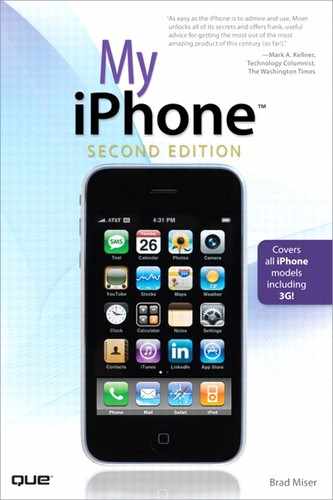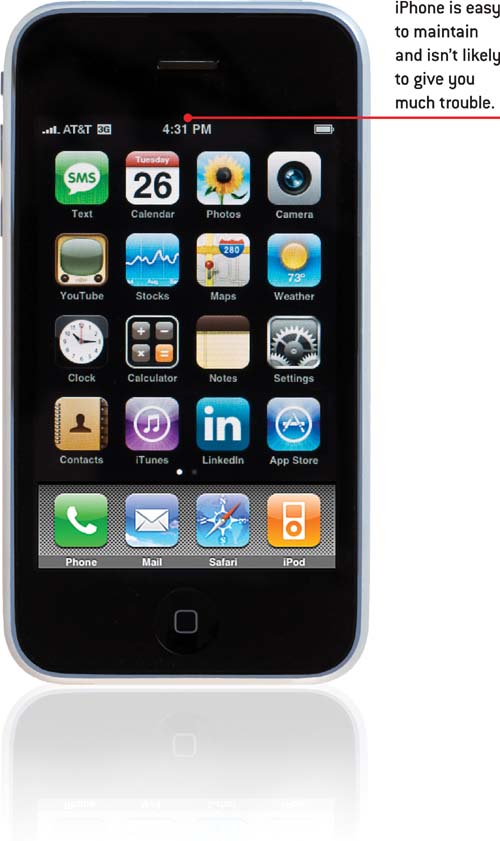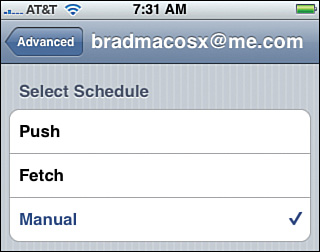In this chapter, you’ll learn how to keep iPhone in top shape and to know what to do should problems happen. Topics include the following:
12 Maintaining iPhone and Solving iPhone Problems
You see that this is a short chapter, and there is a good reason for that: iPhone works very well, and you are unlikely to have problems with it, especially if you keep iTunes’ and iPhone’s software current. When problems do occur, you can usually solve them with a few simple steps. If that fails, there’s lots of help available for you on the Internet.
Maintaining iPhone
Some basic maintenance tasks keep iPhone in top working condition. Even better, you can do most of these tasks with just a couple of mouse clicks because you can configure iTunes to do most of the work for you.
Maintaining iTunes
As you’ve learned in this book, iTunes is a vital partner for iPhone. You should keep iTunes current to ensure that you have the latest bug fixes, new features, and so on. Fortunately, you can configure iTunes to maintain itself.
>>>step-by-step
Maintaining iTunes on Windows PCs
1. In iTunes, choose Edit, Preferences. The Preferences dialog appears.
2. Click the General tab.
3. Check the Check for updates automatically check box.
4. Click OK. The dialog closes. Periodically, iTunes checks for updates. When it finds an update, it prompts you to download and install it. Follow the onscreen instructions to do so.

Check for Updates Now Windows
To check for updates at any time, choose Help, Check for Updates. iTunes checks for updates immediately. If you are using the current version, you see a message telling you so. If an update is available, iTunes prompts you to download and install it.
Maintaining iTunes on Macs
1. Open the System Preferences application.
2. Click Software Update.
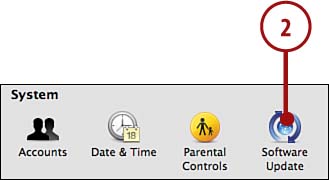
3. Check the Check for updates check box.
4. Choose the frequency that iTunes checks for updates on the pop-up menu.
5. Check the Download important updates automatically check box.
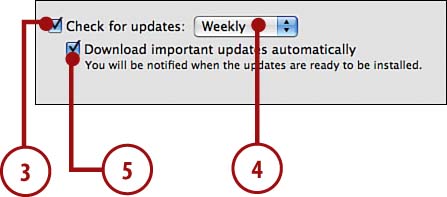
6. Quit System Preferences. The Mac checks for updates for iTunes, along with all the other Apple software on your Mac according to the timeframe you selected. When it identifies an update, it downloads the update automatically and prompts you to install it or prompts you to download and install it, depending on the kind of update it is.
Check for Updates Now Mac
To check for updates at any time, open the Apple menu and choose Software Update. The Software Update application runs. If it finds an iTunes update, it prompts you to download and install it.
>>>step-by-step
Maintaining iPhone’s Software
One of iTunes’ iPhone functions is to maintain iPhone’s software, which is one of the reasons you should keep iTunes current. Periodically, iTunes checks for new iPhone software. When iTunes finds updates, it installs them for you.
1. Connect iPhone to your computer.
2. Select your iPhone on the Source list.
3. Click the Summary tab. You see the current version of iPhone’s software at the top of the screen.
4. If a newer version of iPhone software is available, click Update or click Check for Update to manually check for an update. (If you manually check for an update and you’re using the current version of iPhone’s software, you see a dialog telling you so, and you can skip the rest of these steps. If you aren’t using the current version, the button becomes Update.)
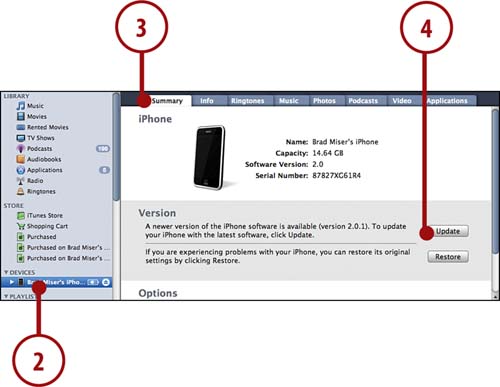
5. Read information about the update and follow the onscreen instructions to download and install it onto iPhone.
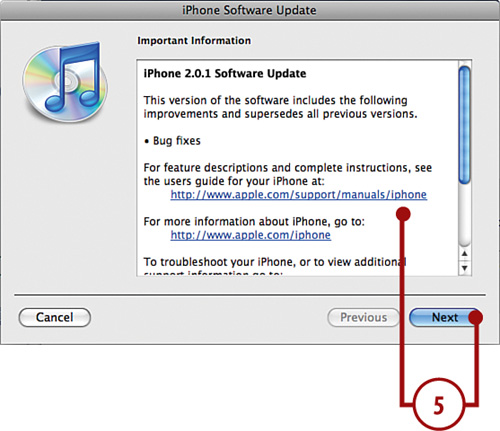
6. Agree to the license agreement.
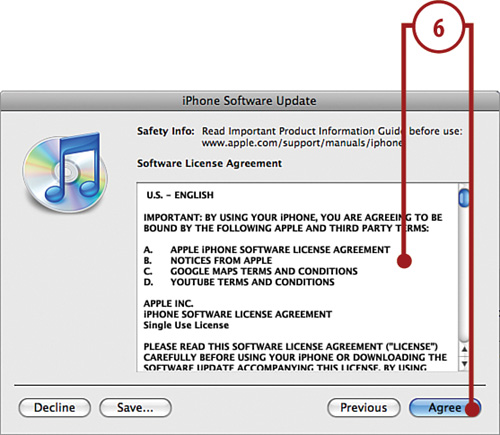






iPhone begins to download and install the update on iPhone. When the software has been downloaded and installed, iPhone is automatically restarted. As the process proceeds, you see various status messages in iTunes. Eventually, iPhone disappears from iTunes, is restarted, and becomes available in iTunes again, and you see that your software is current.
Auto Updates
When you connect iPhone to your computer and an update for iPhone is available, you are automatically prompted to allow iTunes to download and install it. If you don’t allow it, you can always install it later with the following steps.
Maintaining iPhone’s Power

Obviously, an iPhone with a dead battery isn’t good for very much. As you use iPhone, you should keep an eye on its battery status. As long as the battery status is green, you’re okay. As iPhone gets low on power, the battery on the status icon becomes empty and eventually turns red. Two separate warnings will alert you when the battery lowers to 20% and then again at 10%. If you keep going from there, iPhone runs out of power and shuts down. Of course, it gives you plenty of warning through onscreen messages before this happens.
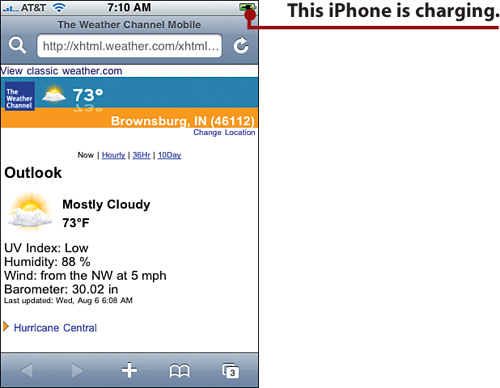
The obvious way to prevent battery problems is to keep iPhone charged. The good news is that all you have to do is to connect iPhone to your computer, and its battery charges. While this is occurring, you see the charging icon in the upper-right corner of the screen, and if you wake iPhone up, a large battery icon showing the relative state of the battery appears on its screen. When charging is complete, the battery status icon reappears, the large battery icon disappears, and you see iPhone’s wallpaper if it’s locked, or you see whatever screen you happen to be using if it isn’t locked.
You can also connect iPhone to the external charger included in its box if your computer isn’t handy.
Keeping iPhone Topped Off
It’s a good idea to keep your iPhone’s battery topped off; this type of battery actually does better if you keep it charged rather than letting it run down all the way before recharging. Periodically, say every month or two, you might want to let iPhone run completely out of power to maximize its life.
With all of iPhone’s capabilities in constant use (accessing the 3G network, push email, and so on), its battery runs out of power relatively quickly; in my typical use while on business travel, I do well to make it through an entire day without having to recharge iPhone. But I have email push turned on with several accounts, use the Web constantly, and often am talking or playing music at the same time. (At press time, Apple released version 2.1 of the iPhone software. One of the benefits touted for this version is a significant improvement in battery life. Hopefully, this will reduce iPhone’s power consumption, so it can go longer between charges.)
To make the battery last as long as possible, consider the following recommendations:
• Put iPhone to sleep when you aren’t using it by pressing the Sleep/Lock button.
• Set Auto-Lock to a small interval, such as 1 Minute. When iPhone locks, it goes to sleep immediately, which puts it in low-power mode (Settings, General, Auto-Lock).
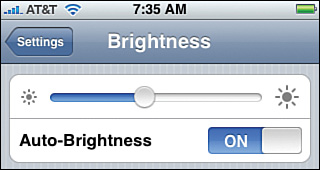
• Set the brightness of the screen to a low but comfortable level and leave Auto-Brightness turned on (Settings, General, Brightness).
• Use a Wi-Fi connection to the Internet whenever you can (see Chapter 4, “Connecting to the Internet, Bluetooth Devices, and VPNs”). Wi-Fi uses less power than the 3G network.
• Disable features you don’t use, especially those that communicate with other devices. Specific suggestions follow.
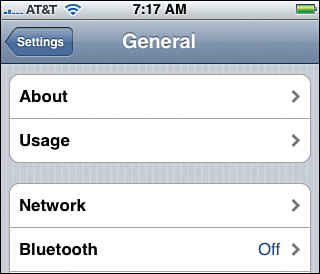
• If you don’t use Bluetooth devices, make sure Bluetooth is turned off (Settings, General, Bluetooth OFF).
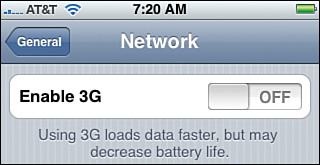
• If you don’t need the speed offered by the 3G network, turn it off (Settings, General, Network, Enable 3G OFF).
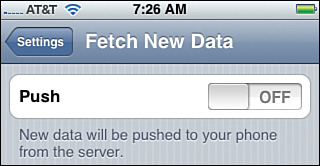
• If you don’t need email to be pushed to any email accounts (see Chapter 5, “Emailing”), disable email push (Settings, Fetch New Data, Push OFF).
• If you do need email pushed to some accounts, disable push for the accounts you don’t need email pushed to (Settings, Fetch New Data, Advanced, email account, Manual).
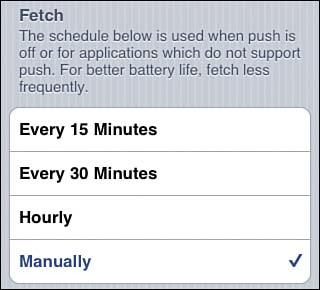
• Set email to be manually fetched instead of automatically fetched. (Settings, Fetch New Data, Manually).
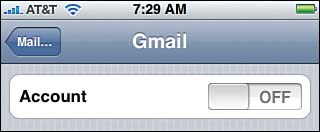
• Inactivate email accounts you don’t need to use at all (Settings, Mail, Contacts, Calendars, email account, Account OFF).

• Run in Airplane mode when you can. When iPhone is in Airplane mode, all the features that require connections to the Internet or other devices are disabled, which are also the features that use power most quickly. It’s fast and easy to move in and out of Airplane mode (Settings, Airplane mode OFF or ON). So, when you want to conserve battery power and don’t need the functions that connect to the Internet or the cell network, enable Airplane mode, whether you happen to be on an airplane or not.
Cleaning iPhone’s Screen
iPhone’s onscreen controls are amazing. But because you use them by pressing and dragging your fingers on the screen, the screen gets smudged. You can clean the screen using the cloth included with iPhone by rubbing it carefully. You should never spray any cleaners directly onto iPhone’s screen. However, you can apply a slight amount of glass cleaner to a very soft cloth and gently wipe iPhone’s screen to clean it. In most cases though, you can get the screen clean with the provided cloth by itself.
Keeping a Clean Screen
If the smudges on iPhone screen bother you, consider adding a clear plastic protector to the screen. There are many kinds of these available (some cases come with one), but they all work in the same way in that they have a side that clings to the screen. You touch the other side, which is more resistant to smudges than is iPhone’s glass screen. Using a protector sheet does change the feel of using and the look of iPhone so you might or might not like to use one. These protectors also help guard against scratches. While iPhone’s screen is pretty tough, it can be scratched.
Solving iPhone Problems
Even a device as good as iPhone can sometimes run into problems. Fortunately, the solutions to most problems you encounter are simple. If those simple solutions don’t work, there’s lots of detailed help available from Apple, and there’s even more available from the community of iPhone users.
The problems that you can address with the simple steps described in this section vary and range from such issues as the iPhone hanging (won’t respond to commands) to iPhone not being visible in iTunes (can’t be synced). No matter which problem you experience, try the following steps to solve them.
>>>step-by-step
Restarting iPhone
If iPhone starts acting up, restart it.
1. Press and hold the Sleep/Wake button until the red slider appears on the screen.
2. Drag the red slider to the right. iPhone powers down.

3. Press the Sleep/Wake button once. iPhone restarts, during which time the Apple logo appears on its screen. When the Home screen appears, try using iPhone again. If the problem is solved, you’re done.
Restarting the Computer and iTunes
If iTunes can no longer see iPhone, restart the computer and open iTunes again.
1. Disconnect iPhone from the computer.
2. Restart the computer.
3. After the computer restarts, connect iPhone to it. iTunes should open, and the iPhone should be selected on the Source list. If so, all should be well. If not, you need to try something else.
Resetting iPhone
If restarting iPhone or the computer doesn’t help, try resetting iPhone using the following escalation of steps.
1. If you are using an application and it freezes, press and hold the Home button down for at least 6 seconds. The application quits, and you return to the Home screen.
2. Restart iPhone using the earlier steps. If the problem goes away, you’re done. If not, continue to the next step.
3. Press and hold down both the Home button and the Sleep/Wake button for at least 10 seconds. You should see the Power Off slider; if you do, shut down and then restart iPhone. If you don’t see the slider, iPhone should turn off and then restart; you can release the buttons when you see the Apple logo on the screen. If the problem goes away, you’re done. If not, continue.
4. If you can use iPhone’s controls, proceed with the following steps. If you can’t use any of its controls, you need to restore iPhone, which the next section explains.
5. On the Home screen, press Settings. The Settings screen appears.
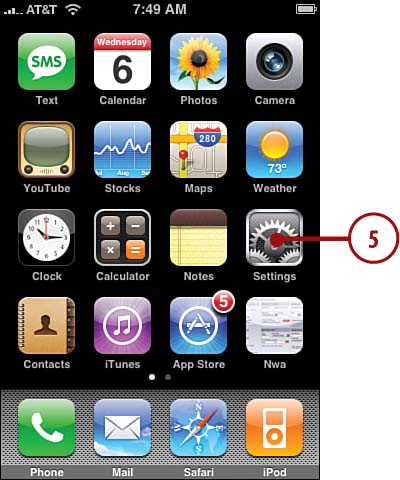
6. Press General. The General screen appears.
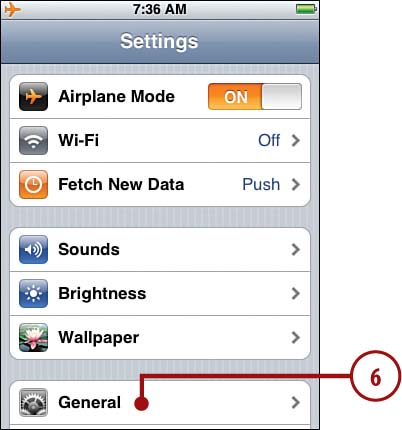
All USB Ports Are Not Created Equal
If your computer can’t see iPhone when it’s connected, try a different USB port. You should use a USB port on the computer itself rather than one on a keyboard or USB hub.
7. Scroll down until you see the Reset command.
8. Press Reset. The Reset screen appears.
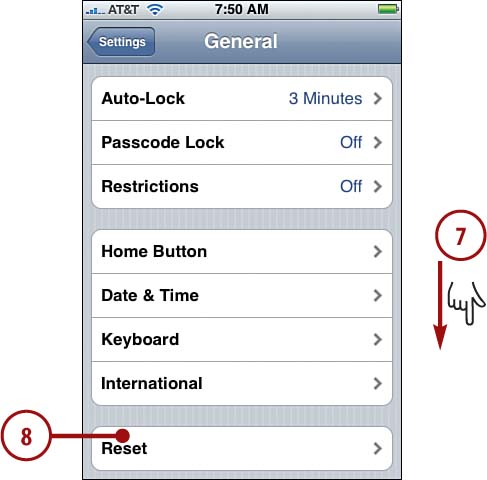
9. Press Reset All Settings.
10. Press Reset All Settings at the prompt. All settings on iPhone reset to their defaults, and iPhone restarts. If the problem goes away, you’re done—except for reconfiguring your settings, of course. If not, continue.
11. Repeat steps 5 through 8 to move back to the Reset screen.
12. Press Erase All Content and Settings. When you do this, you lose all the content on iPhone. Make sure that you have that content elsewhere before you erase iPhone. If the content is in your iTunes Library, you’re fine. But if you’ve added information that you have not synced to iTunes, such as contacts, directly onto iPhone, you lose that information when you erase iPhone.
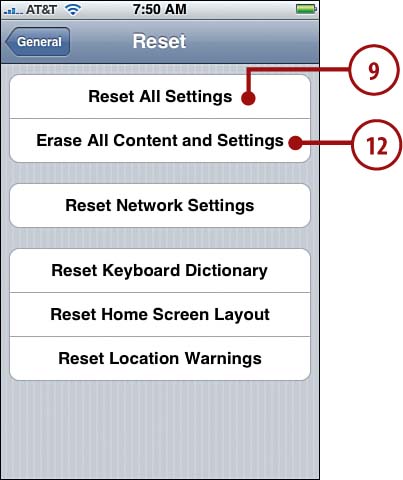
13. Press Erase iPhone at the prompt. iPhone is erased, and it should return to like-new condition. You have to sync it again, reconfigure its settings, and so on. If the problem recurs, you must restore iPhone.
If you are experiencing problems in a specific area, such as connecting to a network, try resetting just that area (for example, Reset Network Settings) before you pull out the big gun by erasing iPhone.
Restoring iPhone
The most severe action you can take on iPhone is to restore it. When this happens, iPhone is erased, so you lose all its contents, and its current software is overwritten with the latest version. If you have added information to iPhone since it was last backed up (when you last connected it to the computer), that information is lost when you restore iPhone so be careful before doing this. If none of the other steps corrected the problems, restoring iPhone should.
1. Connect iPhone to your computer.
2. Select iPhone on the Source list.
3. Click the Summary tab. You see the current version of iPhone’s software at the top of the screen.
4. Click Restore. Remember that you lose everything on iPhone when you restore it, so make sure that you have all its data stored elsewhere before you do this.
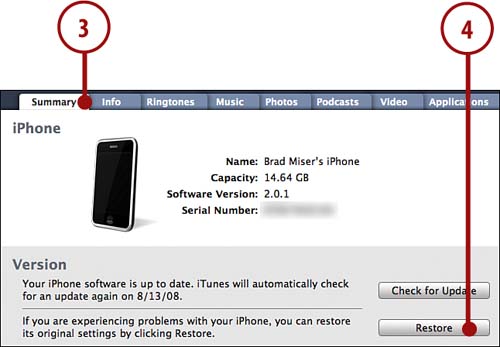
5. Click Restore in the dialog. iTunes erases iPhone and reinstalls its software. This can take several minutes; iTunes displays progress dialogs along the way so that you know what’s happening.
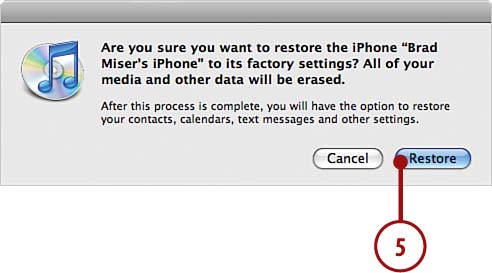
6. When the process is complete, click OK in the completion dialog. iPhone restarts and appears in iTunes just as when you first connected it to your computer. The Set Up Your iPhone screen appears.
7. Click the Restore from the backup of radio button.
8. On the pop-up menu, choose your iPhone’s previous name.
9. Click Continue. iTunes again resets iPhone, and it restarts. This time, your previous information is restored to iPhone so that it’s not quite like starting over, but close to it.
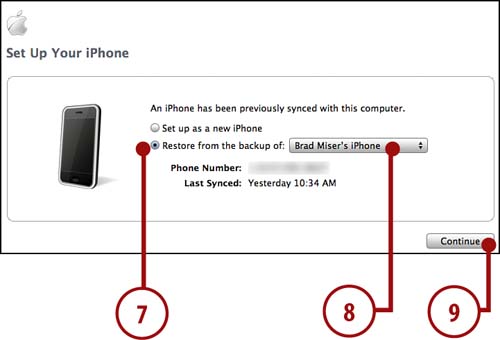
10. Click OK in the completion dialog. iPhone appears on the Source list in iTunes.
11. Using the steps in previous chapters in this book, reconfigure iPhone’s settings, including synchronization options. You do this the same way you did when iPhone was new.
How Does It Remember My Phone Number?
You might wonder how iPhone can be restored. It’s because iTunes backs up critical iPhone settings, such as activation information and some configuration settings, on your computer. Each time you sync, this information is backed up on the computer so that it is available again when it is needed, such as when you restore iPhone.
Reinstalling iTunes
If iTunes continues to be unable to see iPhone and iPhone appears to be working, reinstall iTunes on your computer. (This is much more likely to be necessary on a Windows PC than on a Mac.) See the Prologue for instructions on downloading and installing iTunes on your computer.
No iTunes Content Worries
iTunes stores content, such as music and video, in a different location than the application itself. You can reinstall iTunes without disturbing your iTunes content. Of course, you should always have your iTunes content backed up, such as storing it on a DVD, in case something happens to your computer.
Trouble Sending Email from iPhone?
If you are sure you’ve configured an email account correctly, and you can receive email to that address, but you can’t send any from that address, the provider of the account probably doesn’t allow sending email from any IP address except those it provides. This is most common when the email is provided through an Internet Service Provider, such as a cable company. You have a couple of solutions. One is to access your email through the provider’s web email interface. The other is to add a second email account (such as a Gmail account) to iPhone and use that account when you want to send mail. See Chapter 5 for information about choosing the account through which you are sending email.
Getting Help with iPhone Problems
If none of the previous steps solved the problem, you can get help in a number of ways:
• Apple’s website Move to www.apple.com/support/. On this page, you can access all kinds of information about iPhone and other Apple products. You can browse for help, and you can search for answers to specific problems. Many of the resulting articles have detailed, step-by-step instructions to help you solve problems as well as links to more information.
• AT&T’s website Move to www.wireless.att.com. You can get help with problems you’re having with your connection to the AT&T network, and you can log in to your AT&T account to get information about it.
• Web searches One of the most useful ways to get help is to do a web search for the specific problem you’re having. Just open your favorite search tool, such as Google, and search for the problem. You are very likely to find many resources to help you, including websites, forums, and such. If you encounter a problem, it’s likely someone else has, too, and they’ve probably put the solution on the Web.
• Me You’re welcome to send email to me for problems you’re having with iPhone. My address is [email protected]. I’ll do my best to help you as soon as I can.
